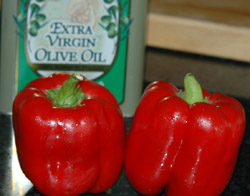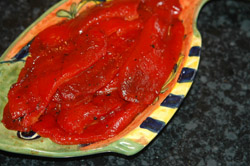 After years of watching various TV chefs skilfully do this or that in front of a live audience I started to make note of all the techniques they perform with the intention of duplicating them exactly. After all I aspire to be an accomplished and reknown chef just like them simply by watching and absorbing the skill while sitting in front of the TV with a Negroni cocktail by my side.
After years of watching various TV chefs skilfully do this or that in front of a live audience I started to make note of all the techniques they perform with the intention of duplicating them exactly. After all I aspire to be an accomplished and reknown chef just like them simply by watching and absorbing the skill while sitting in front of the TV with a Negroni cocktail by my side.
Well, it doesn’t work that way.
I enter as Exhibit A the mythical technique of roasting nice big red peppers on the stove by simply stabbing them with a meat fork and turning them over a live flame for a few seconds whereupon they shed their blackened outer clothing as fast as an exotic dancer in a Las Vegas show.
I watched TV chef Biba Caggiano do this any number of times and eventually concluded that she was using a bit of electronic leger de main with help from the TV crew. Since watching Ms. Biba – long since disappeared from the airwaves – and having at last acquired the essential gas stovetop in my retirement location, I have attempted to duplicate the feat in the apparent 1 minute it took Biba to burn off the skin from a big red pepper.
After a multiplicity of attempts I have happily succeeded in performing the trick. The bad news is that instead of one minute it takes an entire morning or afternoon to process a mere five peppers. Hence the necessity of first becoming a certified retiree before attempting this.
The experience has taught me a few things coming under the heading of “what they don’t tell you”:
- The pepper has to be blackened entirely, even down through the creases found at the top and bottom of the vegetable. No exceptions. Black throughout or put it back on the fire.
- The pepper has to be uniform with fairly straight sides all around. So picking the right peppers at the produce shelves is critical.
- The pepper must not be overcooked in the process. If so it will turn into baby food. This is the biggest challenge.
- Contrary to all the advice given constantly by the experts the pepper’s blackened skin cannot be removed without the help of the water faucet. Heresy is allowed, so bypass this instruction. Using the faucet to rinse off the blackened skin has minimal effect on flavor.
- The defrocked pepper then has to be cut into good looking filets otherwise presentation becomes a serious problem.
- Don’t think using the oven broiler or the outside grill can substitute for the gas fired cooktop. I tried all the alternatives.
 Before divulging my laborious process I am driven to emphasize that roast red peppers locked inside a tin can or glass jar from the store are no substitute for the home-made ritual. I don’t know what possessed the canners and bottlers but the fluid surrounding these deceptively beautiful red filets looks and tastes like something compounded by the Massachesetts General Hospital pharmacy.
Before divulging my laborious process I am driven to emphasize that roast red peppers locked inside a tin can or glass jar from the store are no substitute for the home-made ritual. I don’t know what possessed the canners and bottlers but the fluid surrounding these deceptively beautiful red filets looks and tastes like something compounded by the Massachesetts General Hospital pharmacy.
If there is no other choice, e.g. you have a coil electric, smooth top – God forbid – an induction stove top you are hopelessly driven to the supermarket selections. In that case I recommend dousing the contents in salted water to eliminate the offensive factory brine as much as possible.
Jumping right in to the directions here they are – –
Chef’s Roasted Red Peppers
Start with ones that have uniform relatively straight sides following these steps:
- Rub each pepper with olive oil
- If you don’t have one beg, borrow or steal a gas-fired cooktop. If you don’t put it on your Christmas list.
- Have ready one of those small butane kitchen torches, yes I said a torch!
- Depending on the configuration of the stove burners you may need a small cake rack turned upside down and placed over the flame. This of course ruins the rack but it’s worth it.
- Place the pepper over a medium flame and from time to time turn it with tongs so that all surfaces are blackened as evenly as possible. Do not use a meat fork.
- Toward the finish light up the torch and burn the surfaces that have not blackened thus obtaining a completely blackened pepper.
- Once finished remove the pepper from the heat and stop the cooking by dropping it a large bowl set in the sink and filled with cold water
- Working quickly massage the pepper with your hands under running water until most or all of the skin is removed.
- Place the pepper on the work surface and cut lengthwise following the rib lines to create the filets.
- Trim the filets on both ends, scrape off any remaining skin, toss them in salt and olive oil and reach for the Pinot Grigio. Mission accomplished.
- Repeat the process for the remaining peppers if any, including the Pinot Grigio step.
